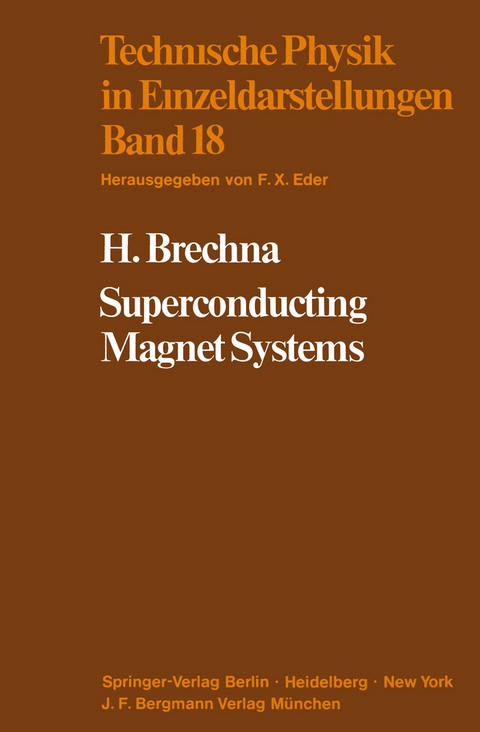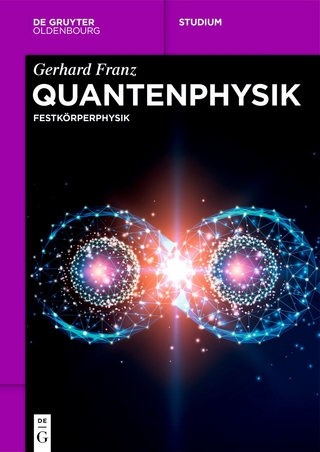
Superconducting Magnet Systems
Springer Berlin (Verlag)
978-3-642-80723-7 (ISBN)
1. Methods of Magnetic Field Generation.- 1.1 High Magnetic Field Laboratories.- 1.2 Conventional Continuous Duty Magnets with and without Iron.- 1.3 Pulsed Magnets.- 1.4 Cryogenic Magnets.- 1.5 Superconducting Coils.- References.- 2. Magnetic Field Calculations.- 2.1 Magnets without Ferromagnetic Yokes.- 2.2 Magnetic Fields due to Coils in Proximity to Ferromagnetic-Materials.- 2.3 Field Calculation of Iron-Bound Air-Core Magnets.- 2.4 Calculation of Forces.- 2.5 Calculation of Heating.- References.- 3. Phenomena and Theory of Superconductivity.- 3.1 Theory.- 3.2 Critical Fields of Type II Superconductors.- 3.3 Critical Currents of Type II Superconductors.- References.- 4. Superconducting Alternating Current Magnets.- 4.1 Alternating Current Losses.- 4.2 Additional Effects in Twisted Multifilamentary Conductors.- 4.3 Eddy Current Losses in Metallic Parts.- 4.4 Multifilamentary Conductors.- 4.5 Comparison of Loss-Calculation with Experiments.- 4.6 Methods of Loss Measurement.- 4.7 Magnetic and Thermal Instabilities.- 4.8 A.C. Magnet Fabrication Techniques.- 4.9 Irradiation Effects in Superconducting Magnets.- References.- 5. Cryogenics.- 5.1 General Properties of Cryogenic Fluids.- 5.2 Low Temperature Processes.- 5.3 Liquefaction and Refrigeration.- 5.4 Handling and Storage of Cryogenic Fluids.- 5.5 Physical Properties of Cryogenic Fluids.- 5.6 Physical Properties of Solids.- 5.7 Heat Losses.- References.- 6. Economic Consideration in the Design of Water-Cooled, Cryogenic and Superconducting Magnets.- 6.1 Introduction.- 6.2 Cost Comparison for Specific Magnet Systems.- 6.3 Cost Comparison in General.- References.- 7. Examples of Superconducting Magnet Systems.- 7.1 The Argonne National Laboratory 3.7-m Hydrogen Bubble-Chamber Magnet.- 7.2 The CERN Liquid Hydrogen Bubble-Chamber Magnet.- 7.3 Composite Magnet System, the McGill and MIT Hybrid Magnets.- 7.4 The Oak-Ridge -IMP -Superconducting Coil System.- 7.5 The SLAC 7 T, 30-cm Bore, Helmholtz Magnet.- References.
| Erscheint lt. Verlag | 15.12.2011 |
|---|---|
| Reihe/Serie | Technische Physik in Einzeldarstellungen |
| Zusatzinfo | XII, 590 p. |
| Verlagsort | Berlin |
| Sprache | englisch |
| Maße | 155 x 235 mm |
| Gewicht | 901 g |
| Themenwelt | Naturwissenschaften ► Physik / Astronomie ► Festkörperphysik |
| Technik ► Elektrotechnik / Energietechnik | |
| Technik ► Maschinenbau | |
| Schlagworte | Supraleitender Magnet |
| ISBN-10 | 3-642-80723-2 / 3642807232 |
| ISBN-13 | 978-3-642-80723-7 / 9783642807237 |
| Zustand | Neuware |
| Haben Sie eine Frage zum Produkt? |
aus dem Bereich


